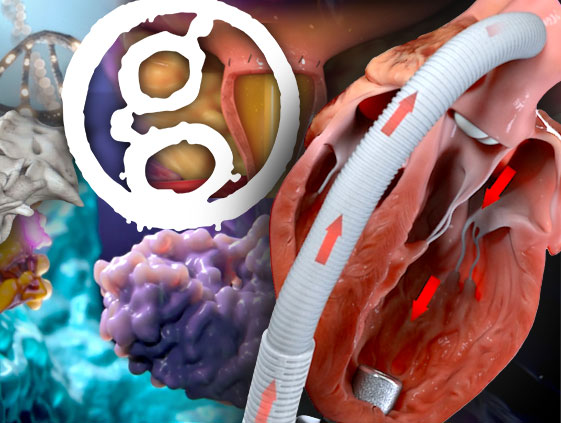Virtual reality (VR) is still in its infancy, but this long-promised, never-previously quite-achieved technology took its first tentative steps into the real world recently, with the official launch of the Oculus Rift headset/VR system. Content suitable for the entertainment or edification of the general public is still largely lacking, but the technology promises to continue the transformation begun by the use of 3D animation — and few industries stand to benefit more than medicine.
3D medical animations comprise relatively familiar and widespread technology made possible by advances in computing. These 3D animations, ordinarily presented in 2D format, represent the natural evolution of science visualization and medical simulation from simple hand-drawn illustrations; to medical animation videos; to fully rendered, computer-enabled 3D medical and/or surgery animations. In some instances, 3D medical animation is being adapted for use in VR environments, further enhancing the utility of this remarkably beneficial technology.
These technologies are being harnessed in labs, hospitals and research facilities around the world to further the noble goals of medicine. These medical technology advances offer obvious benefits for medical education and training. 3D animations bring challenging processes, procedures, devices, concepts, etc., to vibrant life. They can help streamline everything from medical student training to surgeon preparation to patient education; which is often necessary to obtain properly informed consent.
By integrating sophisticated 3D imaging data gathered from specific patients with virtual rendering technologies, it’s becoming possible for doctors to explore the idiosyncrasies of a given patient’s anatomy well before the patient reaches the operating table. Already, surgeons are using this nascent technology to pre-plan the best approaches to surgical interventions — and even to train for any unforeseen challenges — before making a single cut.
VR simulation is also proving extremely useful for “robotic skills acquisition;” meaning training for delicate, increasingly common, robotic surgical techniques. Despite the image of an autonomous machine conjured by the term “robotic surgery,” this technique still relies on the skills of a well-trained surgeon to guide the robot’s functions in the operating room.
Already, research is documenting significant improvements in surgical accuracy and decreases in the time spent planning surgeries. As one recent article noted, in Surgical Innovations, “VR simulation has the potential to become an essential piece of surgical education curriculum …” A related technology, 3D printing, is another example of how 3D imaging and animation are being summoned into the real world.
Physicians are increasingly exploring the potential uses of this relatively new technology in healthcare to assist with everything from the construction of physical 3D models of unique anatomical structures, to “printing” new body parts suitable for implantation. Hyperbole abounds in this arena, but a cursory review of the literature suggests that the possibilities may truly be — if not limitless — at least greater than we have ever imagined so far.
The Cutting Edge of 3D Technology — Bio-fabrication and Beyond
Consider, for example, the case of 3D printed tumors. A team of scientists led by Dr. Wei Sun of Drexel University, in Philadelphia, has pioneered a practical approach to biofabricating cancerous tumors in 3D, with the goal of improving oncologists’ ability to safely destroy such tumors. While much basic oncological research takes place in essentially two dimensions — in tissue cultures growing in petri dishes — it is anticipated that this new approach will provide a more realistic, 3D model to work with as doctors struggle to discover suitable treatments.
Needless to say, this pioneering effort to biofabricate living tissue, which mirrors structures found in nature, has profound implications for the future of medicine in general. Dr. Sun reportedly envisions a future when doctors will routinely biofabricate replacement tissues, organs and other body parts — comprised of living cells — for repair and replacement purposes.
The present biomedical revolution arguably started with 3D medical animations. They’re increasingly used for everything from patient and medical student education; to medical device and pharmaceuticals marketing. However, the full potential of 3D technology is only beginning to come to fruition, with advances in everything from 3D printing to virtual reality; and that’s not even the entirety of what may be on the horizon in this brave new world. Already, a technology referred to in the literature as “4D” is being used to track 3D features as they change over time (the fourth dimension). Stay tuned.
Interested in 3D medical animations for your medical company or practice? Connect with Ghost Productions. Backed by almost 20 years of experience producing 3D medical videos, we have partnered with a comprehensive range of medical industries and specialties creating cutting-edge interactive media, illustration and animation.
Contact Ghost Productions today to learn more.




















